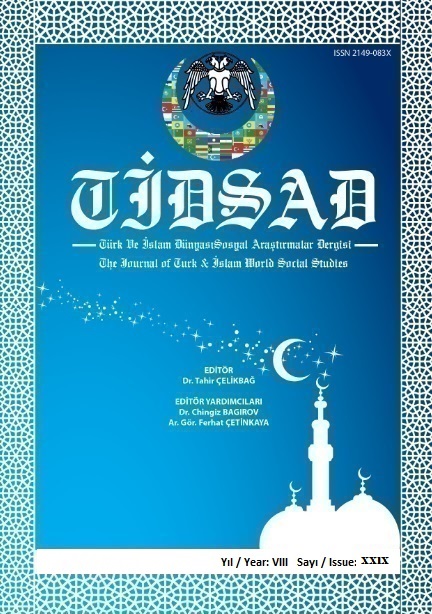Author :
Abstract
Sağlık(-ve-Beden) Toplumbilimi; geleneksel tıbbın bütün veçheleri ile meşguliyetten başka; meslekten olmayanların modern tıbbın branşlarına ve onların erbâbına yönelik tutumları ile de ilgilenir. Tam da bu bağlamda; on-yıllar tutan zaman zarfında halk arasında oluşmuş bir takım kalıp-yargılar da denklemin içine dahil olurlar. Esasen bu gibi inançlar popüler kültür öğelerine nakşolmuştur dense yeridir. Meselâ; bir dahiliyecinin hastayı muayenesi hususunda iki tıktık bir şıkşık ibâresi yaygın surette kullanım bulurdu. Bevliye, tıbbın biraz farklı bir dalıdır; zira akla ilk gelen çağrışımlar, onu, erkekte cinsel iktidar meselesi ile bağdaştırarak bir tür “keyfe keder ya da lüks” tedavi düzlemine yakıştırırlar. Halbuki insan vûcudunun boşaltım aygıtının tamamı, bu ana bilim dalının mevzuudur ve bayan hastalar da tabiatıyla kapsamın içindedirler. Mevzumuz esasen Sağlık Sosyolojisi kapsamında olmakla birlikte; bir anlamda Sosyal Tarih ile de iç içe geçmektedir.
Keywords
Abstract
In addition to occupying itself with all aspects of traditional medicine; Health(-and-Body) Sociology also deals with the attitudes of laymen (non-experts) towards branches of modern medicine and the related professionals. In this very context; a lot of stereotypes which have developed among folks throughout decades are also involved. Indeed, such beliefs are deeply rooted in the popular culture. For instance, a phrase in the line of something like “two successive clicks and a final gentle tap and all is over” used to describe the way an internist examines his patient. Urology is a somewhat different branch of the medicine because the first associations coming to the mind relate it to the issue of sexual potency in the male and accordingly carry it onto a kind of “luxury” or optional-treatment plane. However; the entirety of the excretory system of the human body is the topic of this scientific discipline; whereby female patients also naturally fall into the same category. Even though our topic primarily concerns Sociology of Health; in a sense, it interlaces with Social History, as well.
Keywords
- Abasıyanık, Sait Faik (1952). “Haritada Bir Nokta” (kısa öykü), (e-yayın versiyonu).
- Belli, Vedat F. (1981). “Psikiyatri & Adlî Psikiyatri Üzerine Basılmamış Kürsü Sohbet Seansları”, Çukurova Tıp Fakültesi Adlî Kürsüsü, Balcalı-Adana.
- Canfield, Robert L. (2010). “Efficacy & Hierarchy: Practices in Afghanistan as an Example” in Canfield, Robert L. & Rasuly-Paleczek, Gabriele; Eds.: Ethnicity, Authority & Power in Central Asia: New Games Great & Small, Routledge, New York & London.
- Çaya, Sinan (2018). “Health-and-Body Sociology” İngilizce-Tıp Seçmeli dersi, basılmamış notları; İstinye Üniversitesi, Cevizlibağ, İstanbul.
- Daudet Alphonse (1879, 2009a). “The Poet, Frédéric Mistral” in Letters from my Windmill, (trans. from French by Mireille Harmelin & Keith Adams), a Gutenberg e-Book.
- Daudet Alphonse (1879, 2009b). “The Stars” [“les étoiles”] in Letters from my Windmill, (trans. from French by Mireille Harmelin & Keith Adams), a Gutenberg e-Book.
- Egüz, Saip & Aydıntan, Ziya (1967). Ortaokullara Müzik, Millî Eğitim Basımevi, Ankara.
- Gürsu, Serper et al. (2010). «‘Kadından ortopedist olmaz!’Efsânesini Yıkanlar...», Acta Orthopaedica et Traumatologica Turcica [Dergisi], İstanbul.
- “Kadın Üroloji Uzmanının, Hastalarıyla İlginç Diyalogları” (24. 11. 2014), DHA [menşeli] dijital havâdis.
- Kottak, Conrad Phillip (1997). Anthropology: The Exploration of Human Diversity, McGraw-Hill Companies, Inc., New York.
- Livaneli, Ömer Zülfü (2011). Roman meines Lebens: Ein Europäer vom Bosporus, (Çev. Gerhard Meier), Klett-Cotta Verlag, Stuttgart.
- Sarı, H. H. (2018). “Amerika Birleşik Devletleri’ndaki Sağlık Müzeleri”, Atış, Semih & Çekin, Murat D., Ed.: 3. Sağlık Tarihi ve Müzeciliği Sempozyumu, Zeytinburnu Belediyesi Kültür Yayınları, Kitap No. 51, İstanbul.
- Şafak, Elif (2011). Ehre [özgün başlık: İskender], İngilizce’den Almanca’ya tercümesi: Michaela Grabinger, KEIN &ABER e-Book.
- Taner, Haldun (1969, yeni basım: 2016). Sancho’nun Sabah Yürüyüşü [“Ases” dahil, topluca altı öykü], Yapı-Kredi Bankası Yayınları, İstanbul.
- Tezmen, Gündüz (c.1979 [takribî tarih]). «“Bunalımlar, Dertler” Üstüne Soru-Cevaplı Sağlık Köşesi», Hürriyet Gazetesi, Yıldırım Servis Departmanı, Cağaloğlu-İstanbul.
- Wambaugh, Joseph (1993). Finnegan’s Week, 1st edition, William Morrow & Company Publishers, New York.
- Yıldız, Adnan (18 Eylül 2017). “Ordulu Mustafa”, Memleket Ordu [Yerel Gazetesi], Ordu [vilâyeti].





